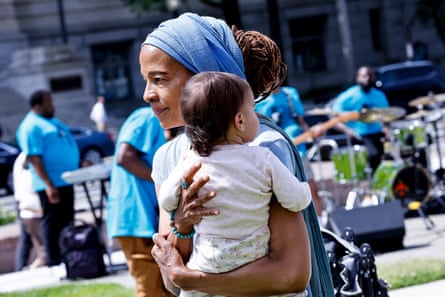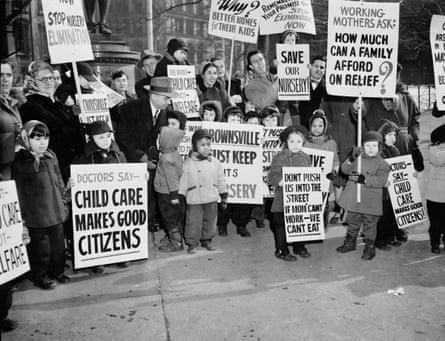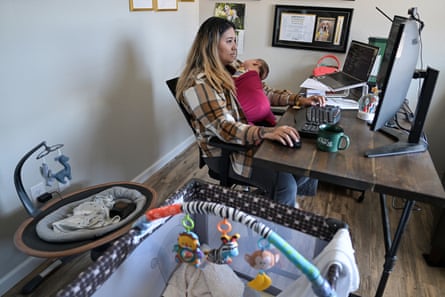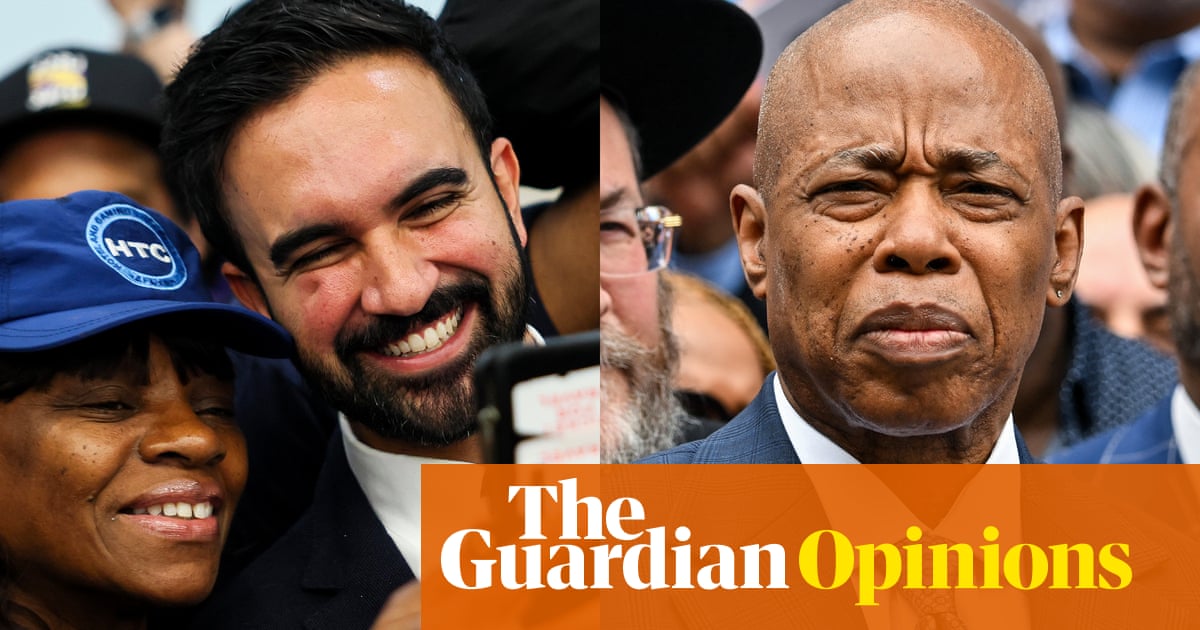In 2021, Bri Adams was pregnant with her first child and began signing up for waitlists for childcare – eight, to be exact. She was thrilled when she found a spot, but was quickly horrified when the childcare shut down abruptly.
It “kind of broke my brain a bit”, said Adams, a 34-year-old tech director from Falls Church, Virginia. Scrambling again, she found a new location close to the family’s home.
Like Adams’s household, two-thirds of US families with young children – including middle- and upper-middle-class families who frequently command politicians’ attention – have had all available parents in the workforce since the late 1990s. Yet parents still struggle mightily to access quality childcare; large majorities say it is hard to find and afford care, and the cost of care continues to rise at a faster rate than inflation.
As near-universal as these challenges are, there is a persistent and surprising lack of a mass movement demanding major childcare reforms. US parents are basically on their own to figure out solutions for their families. Adams “considers herself lucky” that she and her husband, who take home $11,000 each month after taxes, can spend more than $50,000 a year on their two kids’ childcare. Childcare remains their biggest expense, costing a whopping $4,300 a month – $800 more than their mortgage. As Adams asked: “If I am feeling such intense financial stress when we make $300,000 a year, how on earth are people managing who make so much less and have zero safety net?”

Other countries like Canada, Germany and Ireland have made transformative changes to their previously inadequate systems, partly spurred on by parents like Adams. In February 2020, for instance, more than 30,000 parents and childcare providers flooded the streets of Dublin, an event credited with elevating childcare to a top-tier political issue and securing more public funding. Despite the long-broken American childcare system, there has never been a successful and sustained mass mobilization demanding the government do something to fix the problem.
So what has held the US back from achieving such a program, even though polling suggests it would be widely popular for families, and a boon to our communities and economy?
The historical divide in childcare
The US has long had a fraught and contradictory relationship with childcare, one wrapped up in clashes over the role of the family versus the state and tainted by sexism and racism. These tensions culminated with an epic failure in the 1970s, the consequences of which still reverberate today.
For most of the 19th century, working- and middle-class families lived on self-contained farms or ran small family businesses. Young children worked on those farms or in those businesses, and childcare responsibilities were shared among family members. For families of means, beginning with slavery and continuing well into the present day, women of color have provided unpaid or undercompensated care for upper-class families, even while frequently being unable to care for their own families.
During the second world war, with men at war and women taking on the manufacturing jobs at home, the US briefly created a successful, publicly supported childcare system. However, many workplaces restricted mothers from the workplace when the men returned.
But by the late 1960s, mothers were entering the paid labor force in droves, representing one of the largest labor market shifts in modern American history. Organizing efforts came together in 1971 to help Congress pass the Comprehensive Child Development Act, a bipartisan bill that would have begun creating a nationally funded, locally run network of childcare centers.

By this time, however, the progressive New Deal coalition of the 1930s – riven both by the disaster in Vietnam and cultural conflicts at home – was giving way to a free-market order marked by a distrust of government intervention. The act was subsequently vetoed by Richard Nixon on the grounds that it would assert the government’s authority “against the family-centered approach”.
In a span of only 30 years, while the US’s European counterparts began investing in broad-based childcare systems as they needed women to work and rebuild countries devastated by war, the United States went from considering the idea of a federally funded childcare system to entrenched opposition.
Childcare as a ‘private family issue’
Access to childcare has deep economic implications, and it’s also a social issue mired in cultural policies that ask: who gets to work and who should be at home watching kids? Through the 1950s, many companies explicitly discriminated against married women or mothers in hiring or retention. Popular TV shows of the era, from Father Knows Best to The Adventures of Ozzie and Harriet, reinforced a traditionalist view of gender dynamics around care. Even today, many parents continue to say that it is primarily parents’ responsibility to figure out how to make childcare work.
Sandra Levitsky, a sociologist at the University of Michigan who has studied US care movements, explained that deep-seated ideologies were “hard to shift” and believes the leap from being seen as a private issue to a public one is “at the heart” of what needs to change for the movement to expand. “If it couldn’t happen [during Covid] – when women were literally quitting their jobs to care for their kids – what is going to happen now?” she said.
On a national level, childcare has what political science calls a “salience” problem. Today’s voters say they support childcare measures, even regularly approving measures on state and local ballots. Yet very few politicians are elected or defeated due to their childcare stance.
When parents get political
History has shown that parents can, however, be a remarkably effective and galvanized voting bloc: parents led organizing efforts following the Sandy Hook elementary school massacre by launching Moms Demand Action, and conservative parents concerned about Covid school restrictions responded by forming Moms for Liberty. It was a bereaved parent who started Mothers Against Drunk Driving, while in an earlier era, mothers’ groups were instrumental in the fight against child labor through pamphleteering, hosting public lectures and pressuring legislators.
Since the pandemic, multiple major parent organizing efforts with childcare as a main pillar have launched or scaled up, and more philanthropic dollars have flowed to the movement. The increase in childcare advocacy funding is consequential: for decades, childcare organizers have scraped by with limited resources, the equivalent of bringing a horse-and-buggy to the political racetrack.
Chamber of Mothers, of which Bri Adams is a part, was formed in 2021 by a group of social media-savvy mothers incensed after $400bn in childcare funding was dropped from the Build Back Better legislation. The chamber now has dozens of chapters across the nation where mothers come together to build community, learn about public policy issues and organize politically. Another group, Moms First, developed out of an effort to create a “Marshall plan for moms” in the midst of the pandemic, and founder Reshma Saujani was the one who asked then candidate Donald Trump a childcare question during the presidential campaign; Trump’s rambling response about how “the childcare is childcare” went viral. Additionally, several philanthropic entities in 2018 created the Raising Child Care Fund, which provides funding to 20 social justice-focused childcare organizing groups. Collectively, these initiatives point to the type of energy and infrastructure that can help issues leap from private matter to public concern.
The final piece that is missing is a shared vision.

“We don’t have a clear definition of what the what is,” said Natalie Renew, executive director of Home Grown, a philanthropic collaborative focused on strengthening home-based childcare options. “We don’t have a shared consensus to define what childcare is and who benefits from it, and what those benefits and outcomes look like.” Renew points to the divide between groups that organize for childcare using economic arguments to support parents doing wage labor, and groups that organize for childcare using kindergarten readiness as a means to support pre-kindergarten. “But pre-K is not childcare,” Renew said. “It can be part of a childcare solution, but it’s not childcare.”
For all of the challenges, we know change is possible – even on long-held social beliefs – in a relatively compressed period of time. In the past two decades, the US has normalized and enshrined into law the rights of gay people to marry and participate fully in society. We’ve also changed paternity leave from a rare fringe benefit to an increasingly expected workplace leave policy. We may have deeply held beliefs about who takes care of children, but as more generations with different expectations about who can care for their children become parents – and after the wake-up call of the Covid pandemic – we can see a shift potentially beginning to take hold.
Renew, too, is heartened by the changes she has seen in childcare policies and structures at the local and state levels, advances that arguably provide a proof of concept. Buoyed by Covid relief funds, localities had a chance to invest in childcare. “We saw cities and towns putting their flexible dollars to childcare, and they became stakeholders in the conversation,” she said. And as states begin to invest more in childcare systems locally notably in Vermont and New Mexico – more localities are beginning to take notice and have seen how such efforts boost their local economies and families’ wellbeing.
America’s history, prevailing cultural attitudes and an underpowered advocacy ecosystem have all contributed to the current childcare hellscape. But it’s possible that enough parents have begun to look around and ask: why is the United States making this harder than it needs to be? Real change will come when it’s no longer just parents asking that question.

 German (DE)
German (DE)  English (US)
English (US)  Spanish (ES)
Spanish (ES)  French (FR)
French (FR)  Hindi (IN)
Hindi (IN)  Italian (IT)
Italian (IT)  Russian (RU)
Russian (RU)  5 hours ago
5 hours ago























Comments